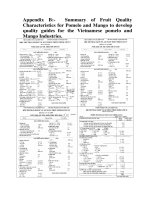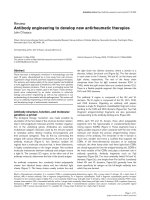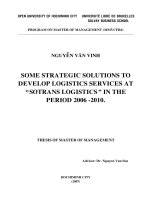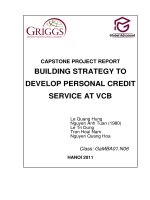apply blue ocean strategy to develop new services for fsi company
Bạn đang xem bản rút gọn của tài liệu. Xem và tải ngay bản đầy đủ của tài liệu tại đây (542.56 KB, 68 trang )
National economics university
Ne u business s c hoo l
Nguyen hung son
APPLY BLUE OCEAN STRATEGY TO DEVELOP NEW
SERVICES FOR FSI COMPANY
supervisor Prof. Dr. TRAN THO DAT
Hanoi – 2013
2
ACKNOWLEDGEMENT
I would like to express my gratitude to all those who gave me the possibility
to complete this thesis.
Firstly I want to sincerely thank to Board of Leader of BSNEU, lecturers,
and management staffs who guide, teach, support, help me in all the time I learnt
and research in the Institute. Knowledge and skills I learned from this course help
me so much not only to complete this thesis but in my work and my life.
I deeply indebted to my supervisor Prof. Dr. Trần Thọ Đạt, Vice president of
National Economics University, whose help, stimulating suggestions and
encouragement helped me in all the time of research for and writing of the thesis.
I want to sincerely thank to BOD of FSI Technology Development and
Trading Investment JSC for giving permission to commence this thesis in the
first instance, providing me with the effective data.
I also gratefully acknowledge the assistance from all of my colleagues at that
helped to supply relevant written material and support me much for the completion
of the thesis.
I have further more to thank to my wonderful EMBA 9B classmates for their
encouragement, support in doing Master of Business Administration in NEU.
Ha noi, November 2013
Nguyen Hung Son.
1
TABLE OF CONTENTS
ACKNOWLEDGEMENT 1
TABLE OF CONTENTS 2
ABBREVIATION 5
LIST OF CHARTS 6
LIST OF FIGURES 7
LIST OF TABLES 8
CHAPTER 1 INTRODUCTION 9
Rationale 9
Research Objectives 10
Research Questions 10
Research Methodology 10
1.4.1.Research process 10
1.4.2.Data collection 11
1.4.3.Data analysis 12
Research Scope 12
1.5.1.Research object: 12
1.5.2.Research scope: 12
Research Structure 12
CHAPTER 2 THE THEORETICAL BACKGROUND ON BLUE OCEAN
STRATEGY 14
Nature of Blue Ocean Strategy and value innovation model 14
2.1.1.Nature of Blue Ocean Strategy 14
2.1.2.Value Innovation – The Cornerstone Of Blue Ocean Strategy 15
Tools for developing new products and services 17
2.2.1.Identify current values of the service on the market 17
2.2.2.Select new value for new products and services according to 4 actions
framework 20
2
Conditions for deploying new services 23
2.3.1.Conditions about cognition 23
2.3.2.Conditions about Resources 24
2.3.3.Conditions about Innovation 24
2.3.4.Conditions about Political 25
CHAPTER 3
DEVELOPING NEW SERVICES FOR FSI 26
Overview Of Fsi Technology Development And Trading Investment Jsc 26
Identify current value on vietnamese office machine market 28
3.2.1.Overview of the market 28
3.2.2.Characteristics of the office machine supplying market 30
3.2.3.Current value curve of office machine supplying services on the market 35
Select new values for Fsi new services 36
3.3.1.Eliminate 37
3.3.2.Reduce 39
3.3.3.Raise 41
3.3.4.Create 44
3.3.5.Summary on value curve of the new service 47
CHAPTER 4
SOLUTIONS AND CONDITIONS FOR DEPLOYING
NEW SERVICES IN FSI 49
Orientation of Fsi‘s strategy on supplying office machines 49
Solutions for implementing new services in fsi 50
4.2.1.Solution for awareness of Leaders and FSI’s staff 50
4.2.2.Solutions for optimization of resources 51
4.2.3.Solutions to save cost and expenses 53
4.2.4.Invest more to R&D activities 54
4.2.5.Other Solutions 55
CONCLUSION 56
3
LIST OF REFERENCES 57
APPENDICES 58
4
ABBREVIATION
ADF Automatic Document Feeder
BOD Board Of Directors
BOM Board Of Managers
BOS Blue Ocean Strategy
CEO Chief Executive Officer
DMS Document Management System
FSI
FSI Technology Development and Trading Investment
Joint Stock Company
ICT Information and Telecommunications Technology
IDC International Data Corporation
IT Information Technology
VCCI Vietnam Chamber of Commerce and Industry
VND Vietnamese Dong
5
LIST OF CHARTS
Chart 3.1: ADF scanners market volume (units) in 2008 – 2011 29
Chart 3.2: ADF scanners market share in 2010 30
Chart 3.3: The present strategy canvas of FSI’s office machine 36
Chart 3.4: The level of interest in the diversify of products and services 38
Chart 3.5: Important Level of payment policy 40
Chart 3.6: Important Level of product quality 42
Chart 3.7: Important Level of product quality 43
Chart 3.8: New value canvas among FSI and main competitors 48
6
LIST OF FIGURES
Figure 1.1: Research Process 10
Figure 2.1: Value Innovation Model in BOS 16
Figure 2.2: The four Actions Framework in BOS 21
Figure 2.3: The example of the Eliminate-Reduce-Raise-Create Grid in BOS 22
Figure 3.1: Printer market share Q III - 2010 28
Figure 3.2: Distribution Channel of Manufacturers 31
Figure 3.3: The Eliminate-Reduce-Raise-Create Grid 37
7
LIST OF TABLES
Figure 1.1: Research Process 10
Figure 2.1: Value Innovation Model in BOS 16
Figure 2.2: The four Actions Framework in BOS 21
Figure 2.3: The example of the Eliminate-Reduce-Raise-Create Grid in BOS 22
Figure 3.1: Printer market share Q III - 2010 28
Figure 3.2: Distribution Channel of Manufacturers 31
Figure 3.3: The Eliminate-Reduce-Raise-Create Grid 37
8
CHAPTER 1 INTRODUCTION
Rationale
When products and services are more and more similar, the competition
between companies will base on prices and profit will more and more decrease.
According to VCCI (Ho Huong, www.vcci.com.vn, 2013), in 2012, there were
53,000 companies have been stopped operating in all the country, total companies
stopped in 2011 and 2012 were 107,000, it equals to all companies had been
stopped in 12 years before that. In the IT hardware market, competition is very
fierce, so creativity and innovation by a suitable strategy play an important role in
deciding survival and development of each company.
Entering the market of IT hardware and office machines supplying lately, in
2007, Fsi faced intense competition with many big and famous companies as Fintec,
Hai Anh, Anh Ngoc… However, FSI selected different market approaching and
together with the best efforts of all staffs, FSI achieved impressed business results;
4 continuous years from 2008 to 2011, the revenue increased more than 2 times per
year; prestige and brand name is known by most of IT and Office equipment
companies in North and Central of Vietnam.
These success are important beginning and they are not big. Beside that, the
gross profit was more and more decreased (10% in 2008 to 5% in 2011) and in
order to keep the company developing in the long-term, strategy analysing and
building is extreme important mission for BOD of FSI included the author.
Although the competition is very fierce especially competing head by head but
with the annual growth rate more than 25%, offices machines market is a high potential
cake and profit will be the reward for companies having smart and efficient strategy.
Those are main reasons that the author has chosen the research: " Apply blue ocean
strategy to develop new service for FSI company” as the subject of the thesis.
9
Research Objectives
The thesis includes these objectives:
Identify current values in supplying office machine service.
Analyze current values that FSI providing to customers in supplying
office machines service
Apply four actions framework of BOS to develop new service for FSI
Analyze conditions and recommend solutions for FSI implementing the
new service.
Research Questions
- What is the current values of supplying office machine service?
- What is the current values of FSI in supplying office machine service?
- How does FSI apply BOS to create new service and what is the new service?
- What is recommendation for FSI implementing new services?
Research Methodology
1.4.1. Research process
Figure 1.1: Research Process
Source: the Author
10
1.4.2. Data collection
- Secondary data
Existing secondary data is collected for analysis purposes. In this study, the
secondary data is gathered from internal sources of FSI used for the thesis, such as:
previous survey results of FSI, new products or services statements and reports,
company profile, website, annual and monthly reports. Statistic figures are
collected, classified, analyzed to be used for the research.
Besides that, public information is also gathered to make the analysis more
convincing. Based on public information both in Vietnam’s IT industry on the
whole, the author has tried to study through Internet, via newspapers, magazines or
other people’s research relating to IT distribution business in Vietnam market.
- Primary data
The author uses two methods to get primary data:
Survey:
• Instrument: questionnaires
• Sample size: 60 traditional customers in Hanoi and other provinces in
Northern and Central of Vietnam market.
• Samples selection method: 45 customers in Ha noi are selected and 15
customers from other provinces (according to nearly 70% revenue is
from Hanoi market). these 60 customers are selected randomly from
customers list of the company 2013.
• Questionnaire delivery methods: answers are collected by 2 methods:
online survey (80%) and direct collected (20%).
• Questionnaire: (Appendix 01)
The goal of the survey is to determine which factors affect to values
customers receive, how are they important and see how well the current products
and services meet customers’ satisfaction. Besides that, one important goals of
customer survey is to recognize the major needs and wants of customers for new
11
products and services in the coming time. Base on the target, content of
questionnaires is focus on what products and services they are using, which factors
they wonder when they choosing the goods, the way they want for delivery
services, payment services, support after sales…
With 60 questionnaires issued, the author got back 45 ones and they are the
sources for the analysis.
In- depth interview
The author has used guiding questions for in-depth interview with 2 top
leader of FSI Company;
The objective of interviews is to identify the company's strategy from the
CEO level and operational strategies for each individual department, aims to better
understand the company's strategy give ocean blue strategy for office machines
supplying, it must be consistent with overall strategy and core values of FSI.
1.4.3. Data analysis
- Use of qualitative and quantitative analysis, descriptive statistics,
comparison for analyzing the data.
- Collected data will be showed on Excel and presented as tables, charts, trends.
Research Scope
1.5.1. Research object:
- To develop new service for FSI company.
1.5.2. Research scope:
- Contents of research: focusing on apply blue ocean strategy to analyze
office machine supplying service to develop new services.
- Time scope: The secondary data will be collected from 2009 to 2012.
The primary data will be collected in 2013.
- Geographical scope of research: The thesis will cover all the market of
FSI. Survey questionnaires are limited in dealers customers.
Research Structure
12
The structure of research includes 4 main chapters:
Chapter 1: Introduction
Chapter 2: The theoretical background on blue ocean strategy
Chapter 3: Developing new services for FSI
Chapter 4: Solutions and conditions for deploying new services in FSI
Company
13
CHAPTER 2 THE THEORETICAL BACKGROUND ON
BLUE OCEAN STRATEGY
Nature of Blue Ocean Strategy and value innovation model
1.
2.
2.1.
2.1.1. Nature of Blue Ocean Strategy
Blue ocean strategy is a strategy that goals are archived by building,
implementing and develop a new market in which there are no competition or
competition is not needed. Normally, a space of market is formulated by 2 oceans:
red ocean and blue ocean.
Red ocean is the market which it’s boundary is defined and companies win
by competing and knock out the competitors. In red ocean, strategy is either
increasing value or cost reducing. Bargaining to enter the market is low, there are
more and more companies joining and profit decreased.
Blue ocean is a new market which boundary is not defined, it is formed by
new demand and high potential, high profit. In blue ocean, strategy is deploying
both innovation and cost reducing. In the blue ocean, competition is not needed
because rules are not formulated.
Table 2.1: Red Ocean Versus Blue Ocean Strategy
Red Ocean Versus Blue Ocean Strategy
Compete in existing market space. Create uncontested market space.
Beat the competition. Make the competition irrelevant.
Exploit existing demand. Create and capture new demand.
Make the value-cost trade-off. Break the value-cost trade-off.
Align the whole system of a firm’s
activities with its strategic choice of
differentiation or low cost
Align the whole system of a firm’s
activities in pursuit of differentiation and
low cost
14
(Sources: BOS)
With definition and nature of blue ocean strategy as analyzed above, the
strategy’s characteristics can be listed as below:
- Ignoring the existed market, the BOS create a new market without
competition
- Not beat the competitors, BOS make competition become not necessary.
- Not fulfil current demand, it create and take new demand
- Not try to balance value and cost. The strategy break the balance of value
and cost.
- Don’t set all activities of the company in the strategy to archive
differentiation or low cost, the strategy set all activities in the strategy
that follow both differentiation and low cost.
2.1.2. Value Innovation – The Cornerstone Of Blue Ocean Strategy
What consistently separated winners from losers in creating blue oceans was
their approach to strategy. The companies caught in the red ocean followed a
conventional approach, racing to beat the competition by building a defensible
position within the existing industry order. The creators of blue oceans,
surprisingly, didn’t use the competition as their benchmark. instead, they followed a
different strategic logic that we call value innovation. value innovation is the
cornerstone of blue ocean strategy. We call it value innovation because instead of
focusing on beating the competition, you focus on making the competition
irrelevant by creating a leap in value for buyers and your company, thereby opening
up new and uncontested market space.
Value innovation places equal emphasis on value and innovation. Value
without innovation tends to focus on value creation on blue ocean strategy an
incremental scale, something that improves value but is not sufficient to make you
stand out in the marketplace. Innovation with-out value tends to be technology-
driven, market pioneering, or futuristic, often shooting beyond what buyers are
ready to accept and pay for. in this sense, it is important to distinguish between
15
value innovation as opposed to technology innovation and market pioneering. Our
study shows that what separates winners from losers in creating blue oceans is neither
bleeding-edge technology nor “timing for market entry.” sometimes these exist; more
often, how-ever, they do not. Value innovation occurs only when companies align
innovation with utility, price, and cost positions. if they fail to anchor innovation with
value in this way, technology innovators and market pioneers often lay the eggs that
other companies hatch. Value innovation is a new way of thinking about and
executing strategy that results in the creation of a blue ocean and a break from the
competition. importantly, value innovation defies one of the most commonly
accepted dogmas of competition-based strategy: The value-cost trade-off. it is
conventionally believed that companies can either create greater value to customers at
a higher cost or create reasonable value at a lower cost. Here strategy is seen as
making a choice between differentiation and low cost. In contrast, those that seek to
create blue oceans pursue differentiation and low cost simultaneously.
Figure 2.1: Value Innovation Model in BOS
16
(Sources: The BOS)
As shown in Figure 2.1, the creation of blue oceans is about driving costs
down while simultaneously driving value up for buyers. This is how a leap in value
for both the company and its buyers is achieved. Because buyer value comes from
the utility and price that the company offers to buyers and because the value to the
company is generated from price and its cost structure, value innovation is achieved
only when the whole system of the company’s utility, price, and cost activities is
properly aligned. It is this whole-system approach that makes the creation of blue
oceans a sustainable strategy. Blue ocean strategy integrates the range of a firm’s
functional and operational activities.
In contrast, innovations such as production innovations can be achieved at
the subsystem level without impacting the company’s overall strategy. An
innovation in the production process, for example, may lower a company’s cost
structure to reinforce its existing cost leadership strategy without changing the
utility proposition of its offering. Although innovations of this sort may help to
secure and even lift a company’s position in the existing market space, such a
subsystem approach will rarely create a blue ocean of new market space.
In this sense, value innovation is more than innovation. It is about strategy
that embraces the entire system of a company’s activities. Value innovation requires
companies to orient the whole system toward achieving a leap in value for both
buyers and themselves. Absent such an integral approach, innovation will remain
divided from the core of strategy.
Tools for developing new products and services
2.2.1. Identify current values of the service on the market
To identify values of office machine supplying service, we will analyze some
characteristics of office machine and office machine supplying service as follow.
Characteristics of Office machines:
17
Office machine is a technological product, certain highly technical complex
so before buying, customers usually careful consider before making decision. Apart
from common printers is relatively cheap prices, professional and high speed
scanners, printers, copiers are quite expensive priced and is an important asset if
customers buy products, so customers tend selection of branded products, good
quality, attentive service warranty.
Also during office use, users often have to replace the consumable supplies such
as toner, drum, brushed or repair the damage after the warranty period, so the
technical service after the sale is a very important part that creating value for customers
By analyzing characteristics and roles of Suppliers, customers, competitors,
new entrants and substitute products, the author rise factors affecting to customers’
value below:
Prices
Buyer power affects profitability of enterprises in the industry by depressing
prices or asking high quality. (Porter, 1979) Because almost products provided to
the market are made by some manufacturers and the quality is similar, time for
warranty is the same, so price is an important factor when customers decide to buy
from one supplier or other.
Value about Payment Policy
With the same price and promotion program, payment conditions or debt
policy is an important factor affect to customers’ buying decision. Sometimes,
customers prefer buying high price with debt rather than buying low price with cash
because they can use cash receiving from their customers after selling and pay to
suppliers without issuing their money.
Diversify of products and services
Diversity of products and services bring convenient for customers because they
can easily choose every products and services they need in one place from one company
18
Value about Quality of products
Quality of product and services is of course one of most important factors that
customers consider when they choose suppliers. Although most of suppliers buy
product from the same manufacturers, same sources of goods but quality of product
sold to the market should different because their management procedures are different,
for example, long time stock or quick test may reduce quality of office machine.
Value about Warranty services
Office machines are technology products require user having basic
knowledge and experience to use, warranty services are essential services that
customers wonder when buying products. Warranty services include the time of
warranty, place of warranty, product swapping policy, conditions for warranty.
Value about Delivery services
Deliver products to the customer or called outbound logistics is one of 5
primary stage bring value to the customer. Fast and in time delivery is the
expectation of almost customers
Value about technical support services
Office machines are specialize electronics equipment made by modern,
complicated and high exactly procedures. In the equipment’s life cycle, to keep
quality of products stability suppliers usually provide maintenance services as:
inspection test, consult and replace spare component. These services help office
machines always work at the highest efficiency with the lowest cost.
In the warranty time, all equipment failure will be fixed free but after this
time, customer need to use charged repair services. The services keep the life cycle
of the machine longer and save money for customers
Value about Customer care services
Customer services include answering all customers’ reply, support customer,
activities to increase customers’ satisfaction and retain their loyalty. It also includes
customer services at contact points (authorize store, authorized warranty center…)
19
Value about Prestigious of supplier
If all values above are similar between suppliers, customers will choose base
on suppliers prestigious and reputation. Prestigious make customers sure about
quality of product and services and believe in all commitment from sellers.
2.2.2. Select new value for new products and services according to 4 actions
framework
To reconstruct buyer value elements in crafting a new value curve, BOS has
developed the Four actions framework. As shown in figure 2.2, to break the trade-
off between differentiation and low cost and to create a new value curve, there are
four key questions to challenge an industry’s strategic logic and business model:
• Which of the factors that the industry takes for granted should be
eliminated?
• Which factors should be reduced well below the industry’s standard?
• Which factors should be raised well above the industry’s standard?
• Which factors should be created that the industry has never offered?
20
Figure 2.2: The four Actions Framework in BOS
(Sources: The BOS)
The first question forces us to consider eliminating factors that companies in
your industry have long competed on. Often those factors are taken for granted even
though they no longer have value or may even detract from value. Sometimes there
is a fundamental change in what buyer’s value, but companies that are focused on
benchmarking one another do not act on, or even perceive, the change.
The second question forces us to determine whether products or services
have been overdesigned in the race to match and beat the competition. Here,
companies over serve customers, increasing their cost structure for no gain.
The third question pushes us to uncover and eliminate the compromises your
industry forces customers to make. The fourth question helps you to discover
entirely new sources of value for buyers and to create new demand and shift the
strategic pricing of the industry.
21
It is by pursuing two first questions (of eliminating and reducing) that you
gain insight into how to drop company’s cost structure. The result is mounting cost
structures and complex business models. The second two factors, by contrast,
provide insight into how to lift buyer value and create new demand. Collectively,
they allow the company to systematically explore how you can reconstruct buyer
value elements across alternative industries to offer buyers an entirely new
experience, while simultaneously keeping the cost structure low. Of particular
importance are the actions of eliminating and creating, which push companies to go
beyond value maximization exercises with existing factors of competition.
Eliminating and creating prompt companies to change the factors themselves, hence
making the existing rules of competition irrelevant.
The Eliminate-Reduce-Raise-Create Grid:
There is a third tool that is key to creation of blue oceans. It is a
supplementary analytic to the four actions framework called the eliminate-reduce-
raise-create grid (see figure 2.3). The grid pushes companies not only to ask all four
questions in the four actions framework but also to act on all four to create a new
value curve.
Eliminate-Reduce-Raise-Create Grid: The Case of [yellow tail]
Eliminate
Enological terminology
and distinctions
Aging qualities
Above-the-line
marketing
Raise
Price versus budget
wines
Retail store involvement
Reduce
Wine complexity
Wine range
Vineyard prestige
Create
Easy drinking
Ease of selection
Fun and adventure
Figure 2.3: The example of the Eliminate-Reduce-Raise-Create Grid in BOS
(Sources: The BOS)
22
By driving companies to fill in the grid with the actions of eliminating and
reducing as well as raising and creating, the grid gives companies four immediate
benefits:
• It pushes them to simultaneously pursue differentiation and low costs to
break the value-cost trade-off.
• It immediately flags companies that are focused only on raising and
creating and thereby lifting their cost structure and often over
engineering products and services - a common plight in many
companies.
• It is easily understood by managers at any level, creating a high level of
commitment in its application.
• Because completing the grid is a challenging task, it drives companies to
strongly inspect every factor the industry competes on, making them
discover the range of implicit assumptions they make unconsciously in
competing.
Conditions for deploying new services
2.3.1. Conditions about cognition
In many turnarounds and corporate transformations, the hardest battle is simply
to make people aware of the need for a strategic shift and to agree on its causes. Most
CEOs will try to make the case for change simply by pointing to the numbers and
insisting that the company set and achieve better results: “There are only two
performance alternatives: to make the performance targets or to beat them.”
But as we all know, figures can be manipulated. Insisting on stretch goals
encourages abuse in the budgetary process. This, in turn, creates hostility and
suspicion between the various parts of an organization. Even when the numbers are
not manipulated, they can mislead. Sales people on commission, for example, are
seldom sensitive to the costs of the sales they produce.
23









